When growing cucumber plants at home, provide them with well-drained soil and plenty of sunlight. Water regularly and fertilize once a month for best results.
Are you interested in growing your own cucumber plants at home? It’s a rewarding hobby that allows you to enjoy fresh, homegrown cucumbers straight from your garden. Cucumber plants thrive in well-drained soil and require a sunny location to grow successfully.
With regular watering and monthly fertilization, you can ensure the healthy growth of your cucumber plants. We will provide you with all the essential information on how to grow cucumber plants at home, so you can start enjoying your own harvest of delicious cucumbers in no time.
Choosing The Right Cucumber Variety
Cucumbers are not one-size-fits-all, and selecting the ideal variety for your garden is crucial to a successful harvest. Consider factors like climate, growing season, and disease resistance when choosing the right cucumber variety for your home garden.
Consider Climate And Growing Season
- Understand your local climate before choosing a cucumber variety.
- Select cucumber varieties that thrive in your region’s specific conditions.
- Ensure the growing season aligns with the variety you choose.
Select Disease-resistant Varieties
- Look for cucumber varieties that are disease-resistant to common pests and pathogens.
- Opt for resistant varieties to prevent issues like powdery mildew or cucumber mosaic virus.
- Consult with local nurseries or extension services for advice on disease-resistant cucumber varieties.
Preparing The Soil For Cucumber Planting
Growing cucumbers at home can be a rewarding and satisfying experience. But before you start planting, it’s crucial to prepare the soil properly to provide your cucumber plants with the best growing conditions.
Ensuring the right pH level, good drainage, and a nutrient-rich environment are essential for the success of your cucumber plants. In this article, we will walk you through the important steps to prepare the soil for cucumber planting.
Test Soil Ph And Drainage
One of the first steps in preparing the soil for cucumber planting is to test the pH level and ensure proper drainage. Cucumber plants prefer slightly acidic soil with a pH level between 6 and 7.
You can easily test the pH level of your soil using a simple soil testing kit or by sending a sample to a local agricultural extension office.
Once you have determined the pH level, you can make the necessary adjustments if needed. If the soil is too alkaline, you can lower the pH by adding organic matter like compost or well-rotted manure.
On the other hand, if the soil is too acidic, you can raise the pH by adding lime. It’s crucial to maintain the pH level within the recommended range as cucumber plants are sensitive to extreme pH conditions.
Aside from the pH level, proper drainage is also crucial for the health of cucumber plants. Cucumber roots can rot if they sit in waterlogged soil for extended periods, leading to plant stress and poor growth.
To ensure good drainage, avoid planting cucumbers in areas with heavy clay soil or where water tends to accumulate. If your soil doesn’t drain well naturally, you can improve drainage by adding organic matter such as compost or vermiculite.
Add Organic Matter And Fertilizers
Adding organic matter and fertilizers to the soil is another important step in preparing for cucumber planting. Organic matter, such as compost or well-rotted manure, helps improve soil structure, moisture retention, and nutrient availability. Spread a layer of organic matter over the soil surface and mix it thoroughly using a garden fork or tiller.
In addition to organic matter, providing your cucumber plants with a balanced fertilizer is essential for their growth and productivity. Before planting, apply a slow-release fertilizer following the manufacturer’s instructions. A fertilizer with an N-P-K ratio of 10-10-10 or similar is generally suitable for cucumber plants.
Keep in mind that cucumbers are heavy feeders and require regular feeding throughout the growing season. Consider using a liquid fertilizer or side-dressing the plants with additional compost or organic matter every few weeks to ensure they receive a continuous supply of nutrients.
By taking the time to test the soil pH, improve drainage, and add organic matter and fertilizers, you can create an ideal environment for growing healthy and vigorous cucumber plants. The proper preparation of the soil sets the foundation for a successful cucumber harvest in your own backyard.
Planting Cucumber Seeds Or Seedlings
When it comes to growing cucumbers at home, the first step is deciding whether to plant cucumber seeds or seedlings. Both methods have their benefits and can lead to a successful harvest with the right attention and care.
In this section, we will explore the process of planting cucumber seeds or seedlings in detail, providing you with the essential knowledge to kickstart your cucumber growing journey.
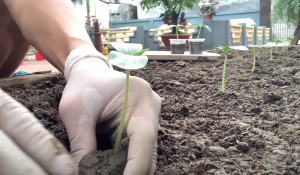
Time Seed Planting Right
Before planting cucumber seeds, it’s crucial to ensure the timing is right. Cucumber seeds are sensitive to cold temperatures, so wait until the soil has warmed up to at least 70°F.
Ensure the last frost date has passed in your area before planting cucumber seeds directly into the soil. This helps to prevent any damage to the delicate seedlings from unexpected frost.
Planting Seedlings With Care
If you opt for planting cucumber seedlings, handle them with care to avoid damaging the tender roots. Create a hole in the soil that is large enough to accommodate the seedling and gently place it inside before covering with soil.
When transplanting cucumber seedlings, make sure to keep them well-watered to help them establish in their new environment. Use a gentle, consistent watering method to prevent shock to the seedlings.
Caring For Cucumber Plants
When it comes to caring for cucumber plants, providing the right conditions is essential for a successful harvest. Proper watering and support are crucial elements in ensuring your cucumber plants thrive. By implementing the following techniques, you can support the healthy growth of your cucumber plants.
Providing Adequate Watering
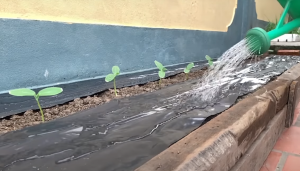
Cucumbers require consistent and thorough watering to thrive. Ensure the soil is kept consistently moist but not waterlogged. A good practice is to water the plants deeply, allowing the water to reach the roots.
Using a soaker hose or drip irrigation system can help maintain steady moisture levels. It’s important to water in the morning to allow any excess moisture to evaporate during the day, reducing the risk of fungal diseases.
Implementing Trellising For Support
Trellising is essential for supporting the growth of cucumber plants and preventing them from sprawling on the ground. By training the plants to grow vertically, you can maximize space and airflow, reducing the risk of pests and diseases.
Secure the vines to the trellis as they grow, using soft ties to avoid damaging the plants. This method also helps keep the fruit off the ground, preventing rot and making for easier harvesting.
Managing Pests And Diseases
When it comes to growing cucumber plants at home, managing pests and diseases is crucial for a successful harvest. Identifying common pests and taking preventive measures for disease control are essential practices that every aspiring gardener should adopt.
Identifying Common Pests
Before jumping into the prevention measures, let’s take a look at some pests that commonly affect cucumber plants:
| Pest | Description |
|---|---|
| Aphids | Tiny, green insects that suck sap from foliage, causing yellowing and distortion. |
| Cucumber Beetles | Yellowish-green pests with black stripes that feed on leaves, flowers, and fruits. |
| Spider Mites | Microscopic arachnids that cause stippling and webbing on leaves. |
By identifying these common pests early on, you can take immediate action to prevent them from infesting your cucumber plants.
Preventive Measures For Disease Control
Preventing diseases is just as important as dealing with pests for a successful cucumber crop. Here are some preventive measures you can take:
- Proper spacing: Ensure adequate spacing between cucumber plants to promote air circulation and reduce the risk of diseases.
- Sanitation: Regularly remove plant debris and weeds from the garden to eliminate potential breeding grounds for pests and diseases.
- Water management: Avoid overwatering your cucumber plants, as excessive moisture can lead to fungal diseases. Water the plants at the base to keep the foliage dry.
- Crop rotation: Rotate the location of your cucumber plants each year to disrupt pest and disease cycles. Avoid planting cucumbers and related crops in the same spot for consecutive seasons.
- Natural predators: Attract beneficial insects like ladybugs and lacewings to your garden. These natural predators feed on common cucumber pests, providing biological pest control.
By implementing these preventive measures, you can greatly minimize the risk of diseases and ensure the health and productivity of your cucumber plants.
Credit: @GardenYard
Harvesting Cucumbers
Knowing when to harvest your cucumbers is crucial for their taste and quality.
Recognizing When Cucumbers Are Ready
- Cucumbers are ready when they reach 6-8 inches in length and are firm to touch.
- Dark green color indicates ripeness, avoid yellow patches.
- Check every 2-3 days for mature cucumbers.
Harvesting Techniques For Best Results
Use sharp scissors or pruners to cut the cucumber stem above the fruit.
- Avoid pulling the cucumber from the vine to prevent damage.
- Harvest in the morning for the best flavor and texture.
- Store cucumbers in a cool, dry place after harvesting.
Pruning And Training Cucumber Vines
Pruning and training cucumber vines are essential practices to ensure healthy growth and maximize your harvest. Understanding the importance of pruning and following a proper guide to training cucumber vines can significantly improve the quality and quantity of your cucumbers.
Understanding The Importance Of Pruning
- Boost Fruit Production: Pruning helps the cucumber plant focus its energy on producing more fruits rather than excessive foliage.
- Prevent Disease: Removing excess foliage improves air circulation, reducing the risk of disease and pest infestations.
- Enhance Fruit Quality: Pruning allows sufficient sunlight to reach the fruits, promoting better color, size, and taste.
Guide To Training Cucumber Vines
- Select a Support Structure: Choose a trellis, stakes, or cage to support the cucumber vines as they grow.
- Start Early: Begin training the vines when they are still young and flexible for easier manipulation.
- Secure the Vines: Gently train the vines to climb the support structure, avoiding any harsh bending or twisting.
- Regular Maintenance: Monitor the growth of the vines and adjust their direction as needed to prevent overcrowding and tangling.
- Prune Wisely: Trim off any unruly shoots or foliage to maintain a tidy and well-structured plant.
Common Mistakes To Avoid
Avoiding common mistakes when growing cucumber plants at home is important for a successful harvest. Ensure you provide adequate sunlight and water, avoid overcrowding the plants, and watch out for pests and diseases. Pruning and trellising can also help to optimize growth and yield.
Overwatering:
One common mistake that many beginners make when growing cucumber plants at home is overwatering. It may seem like giving your plants plenty of water is the best way to keep them healthy, but in reality, overwatering can lead to root rot and other detrimental effects.
When you overwater your cucumber plants, the soil becomes saturated and lacks the necessary oxygen that the roots need to thrive. This can lead to the roots becoming waterlogged and susceptible to disease.
To avoid this mistake, it is important to water your cucumber plants only when the top inch of soil feels dry. This ensures that the roots have access to both water and oxygen, promoting healthy growth. Additionally, make sure to provide proper drainage to prevent water from pooling around the roots.
Underwatering:
On the opposite end of the spectrum, underwatering is another mistake that can hinder the growth of your cucumber plants. Plants that do not receive enough water often become stressed, leading to stunted growth and a decrease in overall yield.
It is crucial to provide a steady supply of water to your cucumber plants, especially during the hot summer months when evaporation is high. The soil should be consistently moist but not waterlogged or overly dry.
One way to ensure your plants receive adequate hydration is by checking the moisture level of the soil regularly. Stick your finger about an inch deep into the soil, and if it feels dry, it is time to water your plants.
Ignoring Pest Infestations:
Pest infestations are a common problem faced by cucumber plant growers. Ignoring the presence of pests can lead to significant damage to your plants and reduce the quality of your harvest.
Common pests that affect cucumber plants include aphids, spider mites, and cucumber beetles. These pests can cause wilting leaves, yellowing, and distorted growth, as well as transmit diseases.
To prevent and manage pest infestations, it is essential to regularly inspect your cucumber plants for any signs of pests. This includes checking the undersides of leaves and the base of the plants. If you notice any pests, it is important to take immediate action.
There are various organic pest control methods available, including introducing beneficial insects like ladybugs or using insecticidal soaps and neem oil. Additionally, practicing good garden hygiene by removing any fallen leaves or debris can help reduce the likelihood of pest infestations.
By avoiding these common mistakes—overwatering, underwatering, and ignoring pest infestations—you can set yourself up for success in growing healthy and productive cucumber plants right in your own backyard.
Frequently Asked Questions
How Much Sunlight Do Cucumber Plants Need?
Cucumber plants thrive in full sun, requiring at least 6-8 hours of direct sunlight daily. Placing them in a spot with ample sunlight will help promote healthy growth and abundant fruit production.
When Should I Start Growing Cucumber Seeds Indoors?
Start growing cucumber seeds indoors 3-4 weeks before the last expected frost date. This will give the seedlings ample time to establish before being transplanted into the garden.
What Are Some Common Pests That Affect Cucumber Plants?
Common pests that can affect cucumber plants include aphids, cucumber beetles, and spider mites. Regular monitoring and appropriate pest control measures can help prevent and manage infestations.
Why Are The Leaves Of My Cucumber Plant Turning Yellow?
Yellowing of cucumber plant leaves can indicate issues such as nutrient deficiencies, overwatering, or diseases. Conduct a thorough assessment of the plant’s care and environmental conditions to address the specific cause.
Conclusion
To sum up, growing cucumber plants at home is a rewarding and achievable endeavor. By following the right techniques, such as providing ample sunlight, consistent watering, and proper trellising, you can enjoy a bountiful harvest of fresh cucumbers. Remember to select the right cucumber varieties for your climate and space limitations.
Whether you have a sprawling backyard or a small balcony, the joy of growing your own cucumbers is unparalleled. So, roll up your sleeves, get your hands dirty, and start your cucumber-growing journey today!

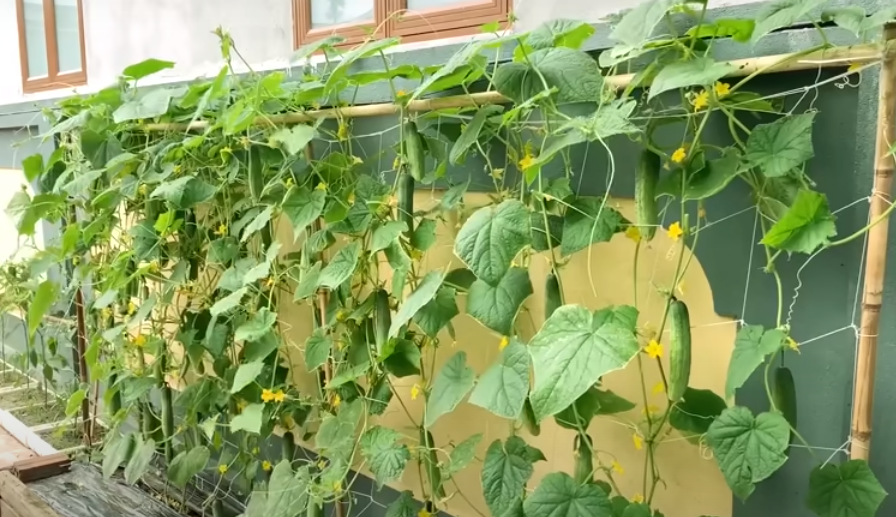

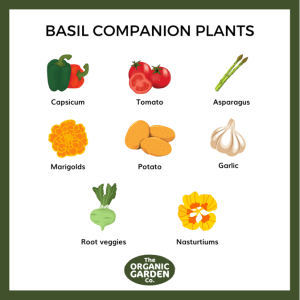

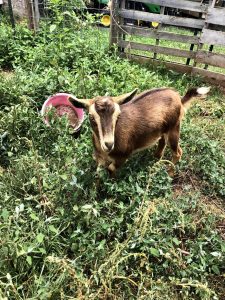
2 Responses